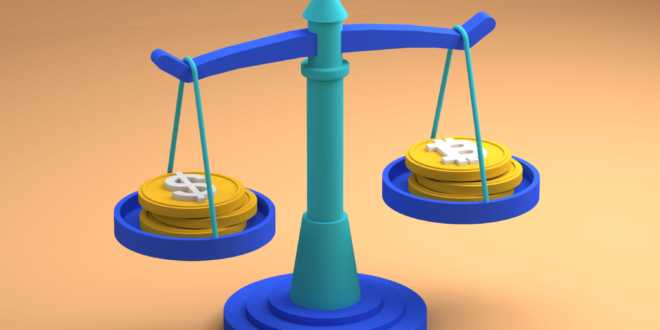Stablecoins are a good option for investors who want to get into bitcoin but are concerned about the high volatility.
While cryptocurrencies like Bitcoin and Ethereum have changed the way many investors interact with and think about money, such as investing in ABC coins, traditional investors may want to stay away from them since values can fluctuate dramatically from one moment to the next.
Stablecoins, on the other hand, are less prone to price fluctuations. They are cryptocurrencies backed by a physical asset, most often a fiat currency. They do, however, retain much of the attraction of other cryptocurrencies, giving investors access to a new and rapidly expanding asset class.
What Are Stablecoins and How Do They Work?
This currency provides a solution to connect fiat currencies like the US dollar with cryptocurrencies. It is a unique alternative to crypto volatility since they are price-stable digital assets that act like cash yet retain the mobility and usefulness of cryptocurrency. Fiat-backed, crypto-backed, commodity-backed, and algorithmic are the four main types of stablecoins, which are distinguished by their underlying collateral structure. You can learn more about the differences between stablecoin, altcoins, and bitcoin by studying more about this here TheTopCoins.
Fiat-backed: Tether (USDT), the first one to come to market with both the widest acceptance and the biggest market value, is popular in this category. While it is linked to the US dollar one-to-one, its solvency is dependent on the strength of its reserves, which only include 3.87 percent cash. USDC is backed by the US dollar. Coinbase and Circle introduced it in 2018. These are centralized, meaning they are owned by a single company or exchange. USDC is handled by Circle and Coinbase.
Crypto-backed: Crypto-backed, as the name explained, are backed by another cryptocurrency as collateral. Instead of depending on a central issuer, this procedure takes place on-chain and uses smart contracts. When you buy a stablecoin like this, you lock your cryptocurrency into a smart contract in exchange for tokens of equivalent worth. You may then withdraw your original collateral amount by putting your coin back into the same smart contract. The most well-known in this category is DAI, which follows this technique. This is implemented through MakerDAO’s use of a collateralized debt position (CDP) to secure assets as collateral on the blockchain.
Commodity-backed: Precious metals, like gold or oil, are used to support this type. Tether Gold, Paxos Gold and The People Reserve coins are the most well-known in this category. Commodity-collateralized stablecoins are more sensitive to price fluctuations, but because commodities are expected to rise in value over time, investors can acquire and keep this asset for financial gain.
How To Use It
One of the most common uses of it is for worldwide payments and money transfers. They make it easy to deposit and withdraw money from cryptocurrency exchanges using fiat currencies.
“Payments are one of the most significant uses of stablecoins,” says Nemil Dalal, Coinbase’s head of crypto.
According to Dalal, “Users may transmit money anywhere in the world in seconds with this currency”. It enables a smooth payment flow since they are a stable currency, making it simple for businesses to safely transmit money to their employees.
10 Things That You Should Know About Stablecoin
- USD are being transferred to public blockchains: These have been increasing their proportion of total value exchanged via Ethereum and Bitcoin during the last year. At the very least, the transfer of money to public blockchains is a shocking fact that few people are aware of.
- The Growth Of Stablecoins Has Been Significantly Accelerated By COVID-19: They added nearly as much market cap in Q1 2020 as they did throughout all of 2019, largely thanks to COVID-19.
- Tether, BUSD (Binance), and DAI were the biggest winners in Q1: Binance’s BUSD experienced the highest increase in Q1, although from a tiny basis, as the Binance exchange extended promotion for BUSD trading pairs. Maker’s DAI profited from the January launch of Multi-Collateral DAI. But the main news was Tether’s ongoing dominance as market players flocked to the most liquid stablecoin.
USDC in late 2018
- Before the launch of USDC in late 2018, Circle conducted market research that revealed that counterparty risk was the market’s top concern: Circle used its trading network to perform market research with traders, investors, and liquidity providers before launching USDC. Potential USDC users were most concerned about counterparty risk. What happens if Circle or the bank that has the reserves goes bankrupt?
Circle teamed up with Coinbase to form the Centre consortium, which will supervise USDC as a membership-based structure and governance mechanism. In 2020, the Centre plans to add more members.
- The Transition of Tether to Ethereum was the Major Story of 2019: Tether used the Omni protocol, a second layer protocol on the Bitcoin blockchain, during the first five years after its inception in 2014. Tether stated in mid-2019 that it will begin producing ERC-20 compatible Tether, a day after Binance announced it would discontinue supporting the Omni protocol.
Tether’s alternative for transferring value on Ethereum has now reached parity with Bitcoin, less than a year after it was launched. It currently accounts for a large portion of the value exchanged via Ethereum.
- Arbitrageurs buy Tether from the Tether Treasury when the price rises above $1: As arbitrageurs take advantage of departures from the peg, research reveals a high connection between the price of Tether and inflows between the Tether treasury and the secondary market. There is a positive flow from the Treasury to the secondary market when Tether trades at a premium. There is a negative flow when it trades at a discount.
- Tether’s move to the Ethereum blockchain resulted in less deviance from the peg and faster reversion: Bitfinex was the sole address interacting with the Tether treasury on the Omni layer until April 2019. Since April 2019, the number of addresses interacting with the Tether treasury has increased dramatically. As a result of the increased access, deviations from the peg are considerably smaller and revert to zero much faster.
Research found there was no correlation
- During times of crisis, this tends to trade at a premium, and when there is a loss of confidence, they tend to trade at a discount: They tend to trade at a premium during times of crisis and/or high volatility, resulting in a flight to safety. When it’s reserves are called into question, or when other events cause a lack of faith, these coins tend to trade at a discount. This is comparable to how, when linked to the dollar, currencies like the Peso trade at a discount if people fear dollar reserves are running low.
- Recent research has refuted previous studies that claimed Tether issuance causes crypto market bubbles: Research found there was no correlation between Bitcoin’s price and the issuance of Tether. Griffin and Shams’ research, which was widely reported, came to a different conclusion.
- The Ecosystem Continues To Depend On Regulators: According to experts, the Center has always prioritized collaborating with regulators, which has become simpler as Facebook/Libra has compelled authorities throughout the world to devote more attention and consideration to it. Regulators, we believe, will continue to be wary of it, concentrating on reserves and concerns related to a “run on the bank.” The central bank’s influence over monetary policy may be eroded, and banks’ ability to create deposits could be curtailed.
Final Words
Although it appears to many to be a secure haven, the impact on cryptocurrencies must also be addressed. This is because huge whales may provide a significant blow to the price of cryptocurrencies while committing themselves to Stablecoin, especially while moving down the market. As a result, we can’t declare that everyone agrees on the existence of it.
 HammBurg Be informed with latest news, reviews, entertainment, lifestyle tips, and much more.
HammBurg Be informed with latest news, reviews, entertainment, lifestyle tips, and much more.




